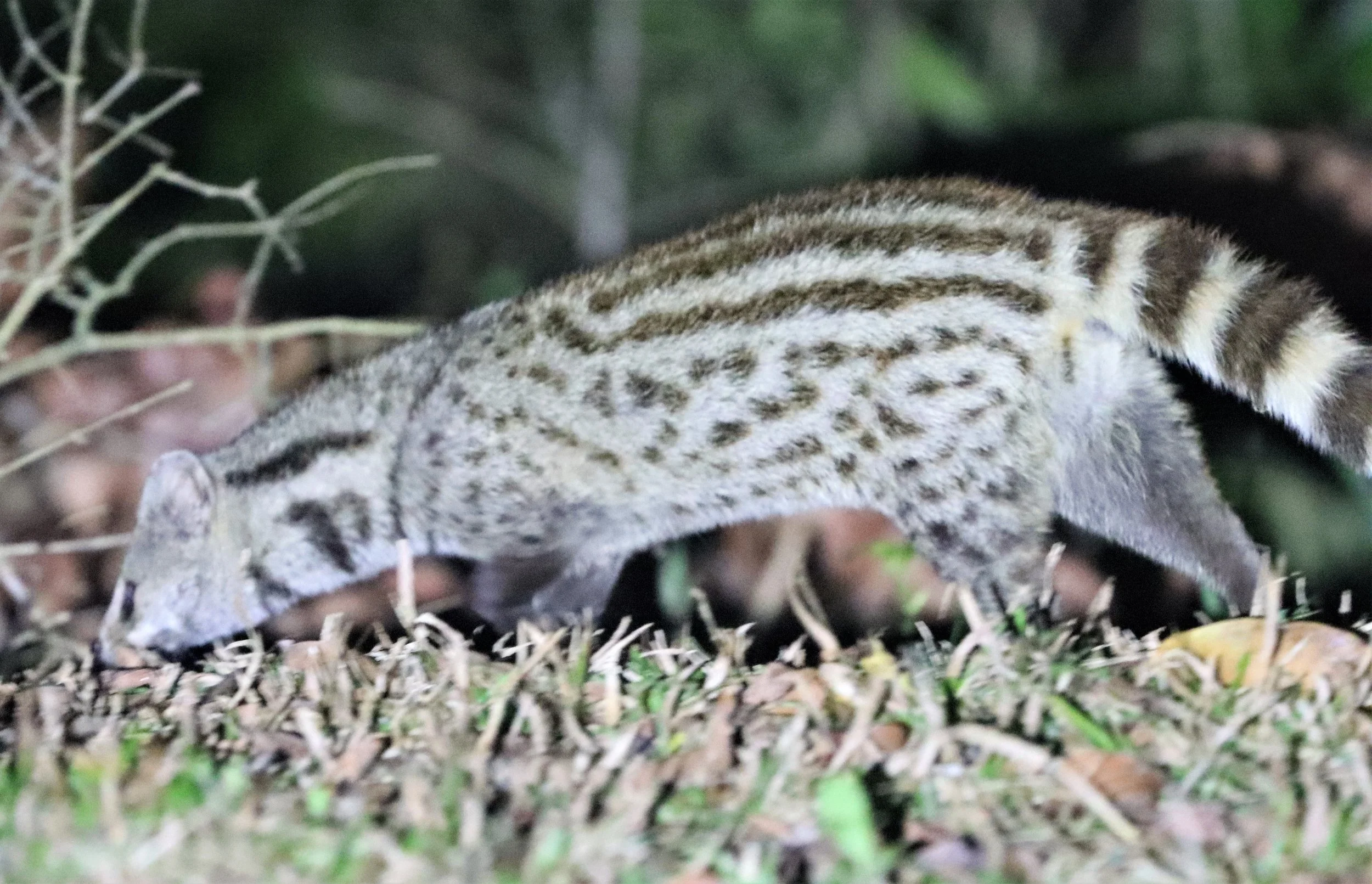
Small Indian Civet
The small Indian civet (Viverricula indica) is a civet native to South and Southeast Asia. It is listed as Least Concern on the IUCN Red List because of its widespread distribution, widespread habitat use and healthy populations living in agricultural and secondary landscapes of many range states. This is the only species in genus Viverricula.
The small Indian civet has a rather coarse fur that is brownish grey to pale yellowish brown, with usually several longitudinal black or brown bands on the back and longitudinal rows of spots on the sides. Usually there are five or six distinct bands on the back and four or five rows of spots on each side. Some have indistinct lines and spots, with the dorsal bands wanting. Generally there are two dark stripes from behind the ear to the shoulders, and often a third in front, crossing the throat. Its underfur is brown or grey, often grey on the upper parts of the body and brown on the lower. The grey hairs on the upper parts are often tipped with black. The head is grey or brownish grey, the chin often brown. The ears are short and rounded with a dusky mark behind each ear, and one in front of each eye. The feet are brown or black. Its tail has alternating black and whitish rings, seven to nine of each colour. It is 53–58 cm (21–23 in) from head to body with a 38–43 cm (15–17 in) long tapering tail.
The Small Indian civet occurs in most of India, Sri Lanka, Myanmar, Thailand, Laos, Cambodia, Vietnam, south and central China, and Taiwan. Recent records are not known in Bhutan, Bangladesh, Peninsular Malaysia, Java and Bali, where it was historically recorded. Its current status in Singapore is unclear.
In Nepal’s Chitwan National Park, it is widely distributed in both grasslands and Sal (Shorea robusta) forest.
In 2008, a small Indian civet was recorded for the first time in Jammu and Kashmir’s Dachigam National Park. This site was located at an altitude of 1,770 m (5,810 ft) in a riverine forest. In northeast India, it was recorded up to an altitude of 2,500 m (8,200 ft). In Tamil Nadu’s Kalakkad Mundanthurai Tiger Reserve, it was recorded foremost in grassland, riverine areas and sighted near a tea plantation during surveys in 2002. In India's Western Ghats, small Indian civets were observed in Tamil Nadu's Anamalai and Kalakkad Mundanthurai Tiger Reserves, and in Kerala’s Parambikulam and Chinnar Wildlife Sanctuaries during surveys in 2008. In Mudumalai Tiger Reserve, it was recorded in deciduous, semi-evergreen and thorn forests, and in the dry season also at a water hole near a village.
In Myanmar, it was recorded in mixed deciduous and bamboo forests in Hlawga National Park. In Hukawng Valley, it was recorded in grasslands and edges of forests at 240–580 m (790–1,900 ft) altitude during surveys between 2001 and 2003. In Alaungdaw Kathapa National Park, it was also recorded in a close tall forest in 1999.
In Thailand, small Indian civets were recorded in Kaeng Krachan and Khao Yai National Parks, in evergreen gallery forest of Thung Yai Naresuan Wildlife Sanctuary, in secondary and dipterocarp forest of Huai Kha Khaeng Wildlife Sanctuary, and in Phu Khieo Wildlife Sanctuary at 700–900 m (2,300–3,000 ft) altitude in deciduous forest.
In Laos, small Indian civets were recorded in a variety of habitats including semi-evergreen and deciduous forest, mixed deciduous forest, bamboo forest, scrubby areas, grasslands and riverine habitat. In Cambodia's Cardamom Mountains, small Indian civets were recorded in deciduous dipterocarp forests, often close to water bodies and in marshes during surveys conducted between 2000 and 2009. Records in eastern Cambodia were obtained mostly in semi-evergreen forest in Phnom Prich Wildlife Sanctuary and Mondulkiri Protected Forest, but also in deciduous diptertocarp forests in Siem Pang Protected Forest, Snoul Wildlife Sanctuary, Virachey National Park and Chhep Wildlife Sanctuary. In China's Guangxi, Guangdong and Hainan provinces, it was recorded in subtropical forest patches during interview and camera-trapping surveys carried out between 1997 and 2005.
The Small Indian civet was introduced to Madagascar. Feral small Indian civets were recorded in Ranomafana National Park in southeastern Madagascar, in an unprotected dry deciduous forest near Mariarano in northwestern Madagascar, and in Masoala−Makira protected areas in the island's northeast. It was also introduced to Pemba Island and Mafia Island in the Zanzibar Archipelago, where it used to be kept for its musk, which is added to traditional African medicine and as a scent to perfume.
Sri Lankan Small Indian Civet (Viverricula indica mayori) Yala National Park Sri Lanka



Siamese Small Indian Civet (Viverricula indica thai) Khao Yai National Park

Viverricula indica thai - Small Indian Civet - Khao Yai NP


































































































































































































Viverricula indica thai - Small Indian Civet - Khao Yai NP Thailand July 2024


















